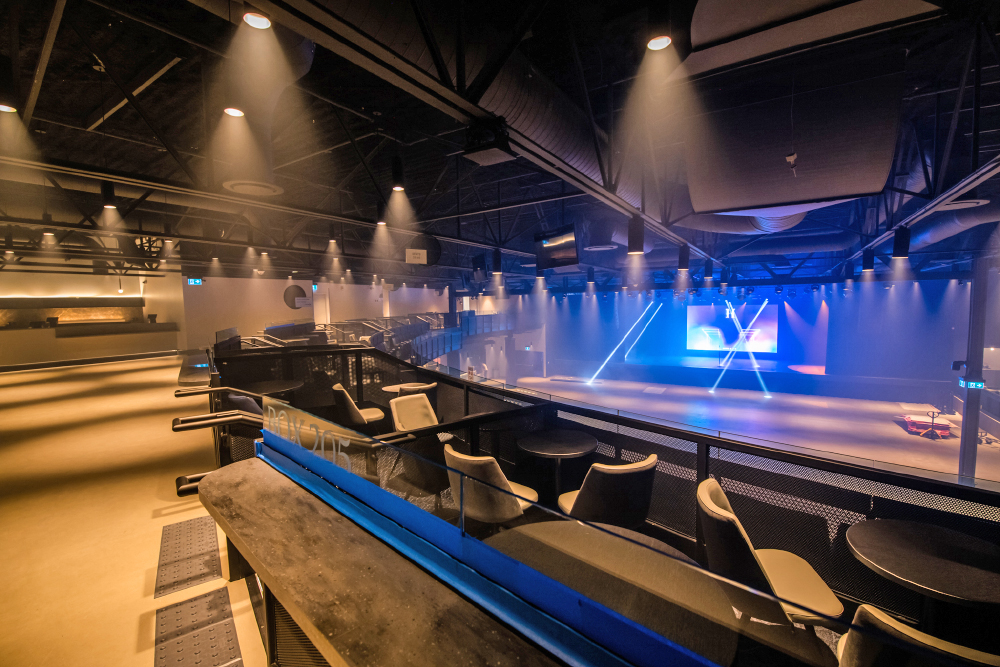One of Toronto’s newest live event spaces, HISTORY, has been getting positive reviews across the board from audiences and incoming artists and crew. Completed in 2021 and located on Queen Street East in Toronto’s Beaches area, the 2,500-capacity live performance room is kitted out to offer the production and audience experience found at large-scale venues and festivals.
In addition to a freshly installed sound reinforcement system – including d&b audiotechnik loudspeakers and Avid Profile consoles – the venue is purpose-built for live shows. Meaning it’s new, shiny, everything works and the quirks that can haunt your day in older “converted” spaces where audio, staging, etc., seem like afterthoughts aren’t an issue.
There’s more to the positive reviews than that. I’m speaking from experience, having played a show with my band (Moist) there in July of this year. It’s not just what’s under the hood technologically that sets HISTORY apart. It’s a culture purposefully fostered with the needs of incoming tours in mind.
“We’ve done about 75 shows now,” says general manager Steven Biasutti when I catch up with him in early August. “One of the main comments we get from incoming tours is how well they’re treated. For club bands, touring North America and globally, from what I’m told, it’s a relief to walk in here.”
Those Who Can…
When hiring the management team, the focus was on experience in the hospitality industry rather than in live music. “That’s by design,” Biasutti says. “Our approach is, if we can do it, then let’s do it, and if we can’t, we’ll die trying.”
“Many people can be technicians, run a security detail or food/beverage service, but first and foremost in those jobs is customer service,” adds David Gardner, technical director at HISTORY. “The last thing anyone wants is a grumpy house tech who says no to everything. We want the band, crew, and fans to walk away with a great experience.”
Gardner’s got a handle on what’s necessary in that department owing to his long-time work as a sound engineer and production/tour manager: “I’ve run the gamut of venues from Toronto’s Horseshoe Tavern up to arenas and stadiums. So I’m taking that knowledge into this.”

On the day of our show, the baked-in “can do” attitude was obvious. Our monitor engineer for the evening, Wa’el Ksaifi, has 20-plus years of audio experience, but he was new to our band and co-headliners The Tea Party, as well as the venue. “You were my fifth show here.” Previously, he’d mixed monitors for DJs at HISTORY, but not rock bands. “I spent time with the input lists and stage plots to create a patch that worked for both. It’s all laid out very simply. That show was a pretty big production, but HISTORY’s a perfect example of things being laid out logically.”
Ksaifi adds that it was the venue’s burgeoning reputation that led him to seek out the gig. “I have friends who saw events here and said it sounded amazing, and they’re people who rarely say that,” he notes. “I wanted to be part of this. Everything works and makes sense, the flow and stage setup. The crew wants to be there – so it attracts technicians, staff, and artists who want to be a part of it, too. That makes for great events.”
The concept was to fill a gap in the Toronto live music market, says Biasutti: “The live music industry in Toronto is vibrant, but lacked 2000- to 3000-capacity rooms. Live Nation saw that, chose this location, and partnered with Drake. I mean, what better ambassador for the city of Toronto?”
Live Nation took possession of the building about five years ago and opened (temporarily between lockdowns) with a sold-out show by Bleachers in November 2021 and then full-time in March 2022. “The building’s owned by Woodbine Entertainment,” Gardner says, “but Live Nation took over 75 percent of it, kept the walls and roof, and gutted the rest, working with Ellis Don and Design Agency.”
Similar-sized venues exist, he adds, but often double as nightclubs. HISTORY is for ticketed and corporate/private events only. It offers a highly flexible layout – a two-tiered space with a general admission section on the main/lower floor and a 365-capacity mezzanine overlooking the stage. Between the North Floor Box VIP side-stage area (a space with a private entrance from the venue’s exterior), a South Floor Box on the main level, and box suites on the Mezzanine, the space can be configured for events of virtually any description.

That flexibility was critical to Live Nation and Drake’s intention to deliver large-scale concert experiences in a mid-size setting. As Drake said in a 2021 press release: “Some of my most memorable shows were playing smaller rooms. I wanted to take those memories and what I learned to create an incredible experience for both the artists and the fans.”
The result is a sleek, modern space corporate clients and artists can brand to their needs with no bad seats in the house, Gardner says: “Not only does the artist have a great experience, the fan experience is elevated because we designed and built it from scratch. At older venues, they’re restricted by what they’ve already got there, whereas HISTORY is totally customizable.”
Biasutti adds: “The concept was to have all the high-end touches you’d see in a large arena. There’s value for bands and audiences in seeing a mid-scale band with all the bells and whistles in a venue where from the stage you can see the facial expression of fans at the back of the room.”
Leaning Heavily
That ethic of providing an arena-sized experience in a mid-size venue and rider-friendliness extended to the AV systems inhabiting the space and the connectivity between them. Live Nation purchased the audio package from PRG Canada, leaning heavily on d&b loudspeakers.
“d&b audiotechnik loudspeakers are always in the top three on everyone’s rider,” Gardner says. “Avid Profiles are older but also rider-friendly.” Over time, he adds, “roughly 60 percent of headliners have brought their own floor package – consoles, in-ear monitors, and floor lighting, so our monitor/consoles are often only used by openers and/or corporate clients.”
System designer Jon Halliwell of PRG has a wealth of experience with d&b – the products being a mainstay for many large venues in Toronto – such as Budweiser Stage, Scotia Bank Arena, and on many festivals – just a smaller iteration. “For HISTORY, d&b’s a great fit. Very few acts that come through there have any issues with the PA.” The J subwoofers, he adds, being “cardioid by nature,” also address concerns of leakage to adjoining buildings.
Note: I must add that even though it’s a relatively low stage and I was directly above subs installed below the stage, the thunderous interference I’ve often experienced in similar situations wasn’t an issue.

The venue is treated with acoustic-rated drywall and insulation. “Even the stage is isolated from the floor – all floating, all purposely done,” Gardner explains. Although the sleek, highly reflective-looking interior might appear to present sonic challenges, “With the acoustics and treatments, it doesn’t,” Halliwell notes. “I was happily surprised by that when we put the PA in.”
That said there were no huge challenges in terms of the system design. “Many concert venues are old theatres, warehouses, or repurposed buildings. There was a plan for how HISTORY was to be engineered and designed ahead of time,” Halliwell details. “We did our first sound design in 2017 but got tied up with zoning/neighborhood meetings. When we did get going again, the pandemic hit, so the challenge was the stop and start nature.”
System Considerations
The main PA consists of eight d&b J Series elements per side powered (in pairs) by d&b D12 amps, with 10 J subwoofers in an arc array configuration in bays (two per bay) under the stage. Two d&b Q7 loudspeakers are flown above the stage, and they are “pretty much in line with the main system, a little further upstage and pointed downwards on a sharp angle to cover the area in front of the stage,” Halliwell says. “If we put them on stage, you’d lose them because the stage isn’t that high. So they’re up, out of the way.”
Four d&b E12s are deployed in the rear of the venue for underbalcony fill, and one additional Q7 was used to provide support for HISTORY’s accessible seating area on the right side of the room.
“Without that, because the stage isn’t centered in the room, we’d have a dead spot there. With it, people on that side get the same experience everyone in front of the full PA in the middle of the room gets,” Gardner says. “We worked with our structural engineer to sign-off on where PRG wanted to put points and where the loads were in the ceiling. And because the space was built from the ground up we could reinforce many different areas knowing during the design process that certain beams would be taking certain loads.”
Since the initial install, two more fills have been added; a pair of Q7s for each of the North/South VIP areas to address overly bossy low end and slap back. “Drake’s been to a few events,” Gardner notes. “He and his team talked to us about that, so we installed them to enhance the overall experience. You can hear roughly 90 percent of the PA in those areas, but there was a bit of a drop-off in the clarity of the top end. On the South platform, one’s hanging off a cable bridge truss horizontally from that. On the North platform, it’s hung off a side wall, vertically, pointing in.”

Being a new, purpose-built live space also allowed them to hang the PA in an optimal configuration. “It’s a left/right hang that we were able to get up quite high,” Halliwell says. “There was a separate contract to put in rigging points, which are right up against the roof. And, with some inverted motors, we got really good trim height on the PA.”
Plug & Play
There’s another Profile desk for monitors along with a dozen d&b M4 wedges, a Q sub drum monitor, four d&b Q Series loudspeakers and four more Q Series subs groundstacked for side stage fill, all powered by d&b D12 amplifiers, which were specified for the monitors that were, again, selected because they’re rider-friendly and match the house PA’s sonic signature.
“If an engineer has a Waves license, all of that’s available,” Gardner says. “But a lot of artists may bring their own console, so we wanted ours to be easy to move in and out, even on a daily basis. So, the consoles, drive rack, monitor system, they’re like a touring or a festival package.” As is the microphone pack, he adds – a mix of Shure, Sennheiser, and Audio-Technica models incoming acts can use or not depending on preference and what they’re carrying.
“For anyone coming in, it’s plug and play,” he adds. “They hand us their lines and have access to the full system. We have a computer at FOH controlling processing, and the tour/event can access all of that. And there’s a three-way split. So, if they’re using the house gear, we can send a set of XLR feeds to record individual channels, or they can put a truck in our loading dock.”
As for customizing coverage for concerts or other events: “We tuned the system with a somewhat neutral tuning, so anyone coming in has a good starting point, but can put their own stamp on it,” Halliwell says. “We have multiple zones and full control over each of them – with two Lake LM44s at FOH for system control and two more on stage. Then we have d&b’s R1 remote control software for the amps. So, complete system control for whatever you want.”
Upping The Game
HISTORY’s lighting and video infrastructure extend the possibilities. In addition to multiple small displays tied into the house video system, a 28- by 16-foot upstage LED wall ups the game for anyone incorporating video/images into their set or just for use as a video backdrop. Shows are captured by Sony 4k robotic cameras and can be broadcast to the dressing rooms, common areas, the production office, and/or to any display in the venue; capabilities that allow any incoming client or artist to create a unique experience for their audience.
“It’s allowed us to work with artists who really are pushing the video content side of things,” Gardner says. “I’ve also been in talks with the higher-ups about enhancing the system, bringing in wireless microphones and a permanent in-ear system for acts.” As for other elements, “We’re always watching what comes through the venue, what’s out there.”
In-house FOH engineer Will Smith has his own take on the audio rig and venue. “The venue is kitted out like a festival. They certainly spent the money in the right places. We offer top-end connectivity, a Lake front end. It’s a J-Series rig, so we’re running R1, but we also have the LM44s so engineers can put their stamp on the system. Whatever anybody wants to do, we have the tools to do it – in-house infrastructure that supports all sorts of signals, BNC, Ethernet capability, and dry analog lines. Jon Halliwell had a real eye for versatility and future-leaning infrastructure that allows us to expand.
“Generally speaking, I split my time 50/50 between corporate and music work. Corporate customers expect everything to be super-clean, polite, professional, and polished. When you apply that to the musical world people are like, ‘you’re doing a great job.’ And vice versa; the skill, the speed, the willingness to roll with it you learn in the musical world flies well with corporates.” At some private or corporate gigs, audio is the redheaded stepchild. That’s not the case here.
Consequently, HISTORY is becoming a highly sought-after venue for private/corporate events. “It’s a concert hall first and foremost,” Biasutti says, “but we’ve had the NHL Awards Gala, a private kind of ‘Welcome back after Covid’ event featuring Tiësto for Click Health, a YouTube staff event. We haven’t had a wedding yet,” he adds, laughing, “maybe in Summer 2023.”

The neighbors in the residential area surrounding HISTORY were initially highly skeptical about the venue – fearing noise and an influx of partying. Biasutti says: “But the majority of shows are over by 11 pm to midnight. Then the tour moves on. People were concerned that, like a nightclub, the concert finishes and then another crowd comes in. Here, the concert/event ends, and we shut down.”
Those concerns were addressed directly at a town hall pre-opening. The whole idea was to enhance the area’s culturally vibrant community and the Toronto music scene in general. “I think now they see Live Nation takes being part of the community very seriously.”
In all, it’s had a positive effect, Biasutti concludes. “We have our challenges. Not with noise, more with egress and patrons leaving. But it’s a summertime problem. In Canada (in the winter), when you leave a venue, you head out immediately because it’s so frigging cold you just want to get out of there. But in the summer, people hang around.”
That said, local businesses don’t seem bothered in the least. “Being the first for anything in a neighborhood isn’t easy. But nearby restaurants are absolutely packed pre-show, and if your restaurant’s going to be filled on a random Tuesday, well, that’s good for everyone.”















